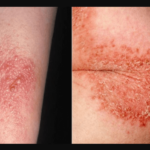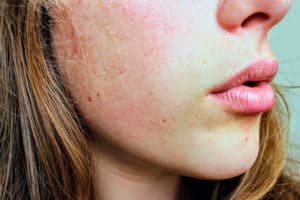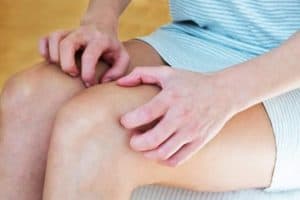Skin peeling is nature’s design to remove dead skin cells. New skin cells replace the dead ones so that the freshness and suppleness of your skin will be maintained. Skin peeling happens all over our body, even in places where we might not think, like the armpit.
Skin irritations, like peeling, are often experienced in parts of the body where the skin frequently rubs against itself. It also occurs in areas where the skin folds over itself. Your armpit is one such part where chafing or skin peeling occurs.
So armpit skin peeling is quite normal. It is usually caused by skin rubbing against skin. It can also occur when the skin rubs with rough clothing for a long time or if it happens repeatedly.
Read on to learn more about armpit skin peeling, what causes it, and how you can treat it.
Also, for an excellent intensive moisturizer, take a look at our top pick, the Elemis Emergency Cream Intensive Moisturizer:
Click here to see it on Amazon.
What Is Armpit Skin Peeling?
When the skin in your armpit excessively peels, it will expose the inner layers of your skin. This peeling will result in new layers to prematurely form.
When this happens, the new skin layers will at first appear reddish. Thereafter, skin peeling will occur. The skin will also be sensitive to touch and exposure to the sun’s rays. You may require treatment to prevent your skin from chronic damage.
Skin peeling is also classified by some dermatologists as underarm rashes. There are at least three types of armpit skin peeling or underarm rashes.
1. Fungal Infection
If your armpit skin peeling is caused by a fungal infection, your underarm skin will have a patchy and itchy rash with an irregular edge. An antifungal cream will be recommended by your doctor to get rid of the infection.
2. Heat Rash
There will be bumps that look like pimples in your armpit. They also tend to itch and burn. Usually, they are the result of perspiration trapped in your armpit. If you use talcum powder, it will absorb the moisture and keep your armpit dry.
3. Intertrigo
This skin condition causes raw and red rashes in your armpit. These rashes develop in the creases of the skin and then spread outward. They are also accompanied by flaking and itching. Intertrigo often occurs when the skin of a moist armpit rubs against itself.
There are other medical conditions or types of armpit skin peeling, but these three skin conditions are the most common. If you have this condition, your medical provider will be able to tell you which type of armpit skin peeling you have.
What Are the Causes of Armpit Skin Peeling?

There are several possible causes of armpit skin peeling.
1. Irritation
If you repeatedly scratch your underarm over a period of time, you may experience armpit skin peeling. Skin irritation from repeated scratching may also cause an infection in your underarm. Your underarm is a good breeding ground for harmful bacteria because it is warm and often moist.
When the skin breaks because of excessive scratching, the risk of developing infection also increases. You can also inflict cuts on your armpit if you are careless in shaving underarm hair.
2. Sunburn
Sunburn will occur if you overexpose your armpit to the rays of the sun. At first, there will be blisters on your skin before armpit skin peeling happens. To prevent skin peeling, you need to use a moisturizer. Using a reliable moisturizer will prevent your skin from being dry and flaky.
3. Eczema
Eczema can also cause armpit skin peeling. This skin condition causes skin inflammation in the folds of the skin. Inflammation is characterized by patches of infected skin, which will appear red, dry, and cracked. They will be itchy and tends to release clear fluid when they are scratched.
4. Contact Dermatitis
Another cause of armpit skin peeling is contact dermatitis. This skin condition arises when the skin gets into contact with an irritant or allergen. You will notice certain symptoms on your skin after a few hours of contact. There will be skin rashes that are reddish, dry, blistered, and itchy.
The most common irritants and allergens are insect bites or stings, food allergens, chemicals in personal care products, cleaning agents, environmental allergens, and medications.
5. Hyperhidrosis
Those who are afflicted with hyperhidrosis are susceptible to armpit skin peeling. This medical condition causes the sweat glands to overwork. It will induce excessive perspiration of the underarms, hands, and feet.
To treat this condition, your dermatologist will recommend the use of a prescription-strength underarm antiperspirant to control excessive sweating.
6. Seborrheic Dermatitis
This skin condition is a type of eczema and one of the causes of armpit skin peeling. It shows up around the oil-producing glands of the body. The symptoms are similar to that of eczema, where the affected skin areas are swollen, reddish, greasy, burning, and itchy. Later, the skin will become flaky and yellowish-white in color.
7. Sweating
If you use natural deodorants, nothing will stop your armpits from sweating because they are not antiperspirants. As a result, your armpit will always be wet and moist. Moreover, the skin on your armpits will be sticky as it rubs against itself. There will be a lot of friction that will result in skin irritation.
After some time, your armpit skin will turn red and feel itchy. This skin condition is called intertrigo. It is the most common cause of armpit skin peeling and underarm rashes.
8. Baking Soda
Adding too much baking soda to a deodorant will also cause armpit skin peeling. High concentrations of baking soda will increase the alkalinity of your deodorant and make your deodorant too abrasive. For this reason, skin rash often develops. Additionally, if your deodorant is sticky, you will be more prone to skin chafing.
9. Allergy
Using a deodorant that you are allergic to will also cause armpit skin peeling. If you suspect that this is the case, try not to use the deodorant for a couple of days and see what happens.
Some deodorants contain aluminum chlorohydrate. This substance could block your skin pores and induce the development of pimples. If the skin rashes stop, then the culprit is probably your deodorant.
Use a hypoallergenic deodorant to reduce the chances of armpit skin peeling. However, if the rashes become worse, you need to consult a dermatologist for proper diagnosis and treatment.
What Are the Symptoms of Armpit Skin Peeling?
It is important for you to know the symptoms of armpit skin peeling so that you will be able to stop it right on its tracks. Here are some of its symptoms:
- Skin redness
- Persistent itching
- Underarm bumps
- Swelling of the skin
- Peeling skin syndrome
Peeling skin syndrome is a more generalized skin condition that is characterized by the short stature of newly formed hairs. You can easily pluck these hairs, unlike normal hairs. This condition is caused by the superficial detachment of the outer horny layers of your skin.
What Are the Treatments for Armpit Skin Peeling?

As there are many probable causes of armpit skin peeling, there are also a lot of treatments that can lessen ad prevent the peeling.
1. Regular Use of Moisturizing Cream
One of the most common treatments of armpit skin peeling is the regular use of a moisturizer. A product that you can consider is the ELEMIS S.O.S Emergency Cream, Intensive Moisturizer.
Click here to see it on Amazon.
This cream is an intensive moisturizer that you should use daily. It will soothe sensitive, blemish-prone, and dry skin while replenishing the skin’s hydration balance.
2. Treatment for Seborrheic Dermatitis
Here are some of the ways to treat this specific skin condition:
- Topical Medications – Application of topical corticosteroids, non-steroidal creams, or prescription-grade antifungal creams when there are skin flare-ups. Only use these medications according to your healthcare provider’s instructions.
- Antifungal Creams – The Angular Cheilitis Treatment and Thrush Clotrimazole Antifungal Cream 1% is one of your options. This product can relieve discomfort, burning, cracking, itching, and scaling of the infected skin area.
Click here to see it on Amazon.
- Exfoliating Products – Use of exfoliating products in alternating days to soften scaly patches.
- Zinc – Wash the affected area with products that have zinc pyrithione.
3. Treatment for Eczema
If the underlying cause of your armpit skin peeling is eczema, here are your treatment options:
- Administration of phototherapy, where your armpit will be treated with ultraviolet light to increase the production of vitamin D.
- Application of topical steroid creams.
- Administration of biologic medications that will supply engineered or synthetic human immune proteins.
- Application of topical calcineurin inhibitors.
4. OTC Remedies
There are some OTC options that can help relieve various skin irritations and allergic reactions. If these skin problems are left untreated, they may lead to armpit skin peeling.
- Application of antifungal cream, spray, or gel on the affected area every day for two weeks, especially if ringworm or Candida infection are suspected.
- Oral administration of antihistamine medications. Some of these medicines can cause drowsiness, making you feel sleepy. Antihistamines can help reduce your chances of scratching the infected area.
- Application of hydrocortisone cream (0.5 to 1.0 percent) twice or thrice a day for a couple of days.
- Application of calamine cream or lotion.
- Application of moisturizers to the affected skin area. The Peter Thomas Roth Peptide 21 Lift & Firm Moisturizer could be one of your options. This moisturizer contains proteins, neuropeptides, and peptides that will deliver intense moisture to your skin.
Click here to see it on Amazon.
5. Home Remedies
Below are home remedies that you can use if you are reluctant to apply synthetic chemical substances on your skin:
- Application of sunflower oil
- Application of coconut oil
- Application of topical vitamin B12
- The use of an herb called Cardiospermum in ointment form
- Massage
- Biofeedback
- Meditation
- Hypnosis
- Acupressure (involves the application of pressure to specific points in your body)
Other home remedies include:
- Wearing loose clothing to keep the affected area dry.
- Avoiding long showers and swimming for long periods of time.
- Taking lukewarm showers or baths with added baking soda, salt, vinegar, or oatmeal. Oatmeal baths can soothe irritation and itching caused by eczema. It can also moisturize dry skin. You can buy an oatmeal bath preparation from drug stores or you can pour ordinary oatmeal into a bathtub full of warm water.
- Avoiding overexposure to the sun’s rays.
- Applying glycerol-based or unscented moisturizers on your dry and scaly skin twice or thrice a day.
- Tapping or patting itchy skin instead of scratching it.
Please take note that chronic armpit rashes or skin peeling may require treatments that only dermatologists can provide. In a majority of cases, your doctor may recommend a combination of home remedies and OTCs before prescribing specific medications.
How to Prevent Armpit Skin Peeling
If you already know the causes of your armpit skin peeling, you will be able to prevent its development. To prevent the development of this skin condition, follow these tips:
- Wear loose clothing made of organic fabric during warm weather conditions.
- Use personal care products that are fragrance-free and unscented.
- Wash your clothes, towels, and beddings frequently.
- Identify allergens early and avoid them as much as possible.
- Make sure all of your pets are vaccinated.
- Wear undergarments that fit you properly.
- Do not share clothing, combs, and towels with other people.
- Use lukewarm water for bathing but don’t bathe in it for too long.
- Wash your hands or take a shower after working with animals, plants, and soil.
- Apply anti-chafing powder after exercising and during warm weather.
Conclusion
Armpit skin peeling occurs when skin rubs against itself. Your armpit is one part of your body where skin always rubs against skin. The natural consequences will be redness, itchiness, and dryness of the skin, which will result in skin peeling and other skin conditions.
If you will follow the treatments discussed in this article, you will be able to stop this skin condition or prevent it from getting worse.
Related reading:
Bottom of Feet Peeling: Causes and Treatments
How Long Does Skin Peel After a Sunburn?







![Bleeding Pore on Nose [11 Possible Causes and Treatments] bleeding pore on nose](https://skincaregeeks.com/wp-content/uploads/2021/04/bleeding-pore-on-nose-150x150.jpg)
![Bruise Itches [Causes and Treatments for an Itchy Bruise] bruise itches](https://skincaregeeks.com/wp-content/uploads/2021/04/bruise-itches-150x150.jpg)
![Neutral Skin Tone Defined [and Best Colors for Neutral Skin] neutral skin tone](https://skincaregeeks.com/wp-content/uploads/2021/05/neutral-skin-tone-150x150.png)



![Read more about the article Noxzema for Sunburn [Is Noxzema Good or Bad for Sunburn?]](https://skincaregeeks.com/wp-content/uploads/2020/12/noxzema-for-sunburn-300x200.jpg)

